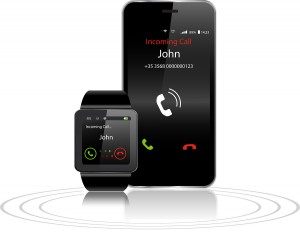The Apple (NASDAQ:AAPL) iWatch, whose name was confirmed by a trademark filing in Japan on July 1st, 2014, has proven to be a rich field for speculation and opinion. Analysts from around the globe have presented their opinions about the wearable electronics device, developing scenarios sharply at odds with each other on the basis of the same set of information. A survey of the theories provided by experienced, self-assured, highly competent investment experts runs such a gamut that it resembles undiluted chaos.
Analysts and news “leaks” cannot even agree on what shape the iWatch will have. Round iWatches have been forecast with a good deal of certainty, but other sources have offered confident arguments that the iWatch will be square or rectangular. Some analysts have exhumed long-forgotten Apple patents appearing to show round or square watch-like devices in an effort to bolster their arguments.
 Some experts have forecast that the iWatch will appear early. Others, such as the highly vocal Ming-Chi Kuo of KGI Securities, assert forcefully that the iWatch is being delayed by various problems, ranging from obtaining FDA certification to problems with manufacturing, materials, and so on. By some optimistic estimates, the iWatch should already be on the street, while certain pessimists doubt it will be seen before 2015.
Some experts have forecast that the iWatch will appear early. Others, such as the highly vocal Ming-Chi Kuo of KGI Securities, assert forcefully that the iWatch is being delayed by various problems, ranging from obtaining FDA certification to problems with manufacturing, materials, and so on. By some optimistic estimates, the iWatch should already be on the street, while certain pessimists doubt it will be seen before 2015.
Estimated price points range from extremely cheap (under $200) to extremely expensive (thousands of dollars, like a fine Swiss watch). Some analysts predict the smartwatch will be a complete flop, and others say that stratospheric sales can be expected. Varying effects on Apple’s (AAPL) bottom line are also anticipated, ranging from almost nothing to unprecedented profits and soaring share values.
Nor can the experts agree on what features the iWatch will offer, with guesses ranging from a very ordinary smartwatch (though perhaps an extremely fashionable, “designer” one) to something that is essentially a miniature medical lab with an iPhone, iPod, and iKitchenSink thrown in for good measure.
The truth of the matter, of course, is that nobody except a select group of Apple executives and designers know what the iWatch is, what shape it will be, what price point is being aimed at, how many models will be produced, what materials will be used, or what functionality it will offer.
The maelstrom of contradictory guesses about the iWatch’s future, however, does serve as a timely reminder that, as analysts vie for page views, they are themselves operating mostly from guesswork. All of the individuals involved are highly educated and highly experienced investment and technology experts, yet they construct absolutely opposing scenarios from the same data points.
And this, in turn, serves to highlight the fact that despite its scientific trappings, much of investment forecasting is little different from placing a bet on a roulette wheel and hoping that one’s guess is actually proven right by totally unpredictable forces beyond one’s control or ability to analyze.



